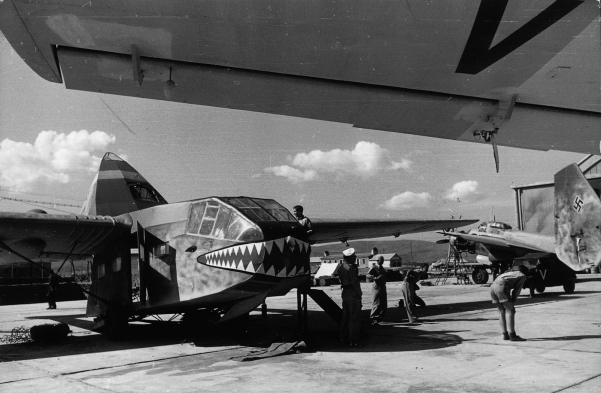
Well known as a producer of bomber aircraft for the German Air Service during World War I, Gotha re-entered aircraft production in 1936 and after the outbreak of war devoted its attentions to the design and manufacture of military aircraft. The most successful of its wartime designs was the Go 242, a high-wing twin-boom monoplane with a central nacelle that could accommodate 23 fully equipped troops. Introduced into service in 1942, the Go 242 subsequently became the Luftwaffe’s standard transport glider, with deliveries totalling 1526 Go 242A and Go 242B gliders with skid and wheeled landing gear respectively.
Typically, the aircraft were towed by Ju 52 or He 111 aircraft, and were used during the daring airborne invasion of Crete in May 1941. The Go 242 was designed with a view to the installation of engines, and its success paved the way for the Go 244, which was powered with French engines. Deliveries totalled 174 aircraft, including 133 converted Go 242B gliders. Of this latter type there were five versions: the Go 244B-1 freighter with torsion-bar shock absorption, Go 244B-2 freighter with wider track main units and oleo shock absorption, Go 244B-3 and B-4 paratroop transport versions of the Go 244B-1 and B-2, and Go 244B-5 with dual controls and balanced rudders.
Specifications
- Manufacturer
- Gotha Waggonfabrik
- Type
- Troop Transporter
- Length
- 15.80m (51ft 10.25in)
- Span
- 24.50m (80ft 4.5in)
- Height
- 4.60m (15ft 1in)
- Maximum Speed
- 290km/h (180mph)
- Service Ceiling
- 7650m (25,100ft)
- Range
- 740km (460 miles)
- Crew
- Two
- Powerplant
- 2 x Gnome-Rhòne radial
- Armament
- 4 x 7.92mm MG
- Bomb Load
- Not Available
- First Flight
- Not Given
- Initial Climb
- 270m (885ft) per min
- Weight (empty)
- 5225kg (11,517lb)
- Weight (loaded)
- 7800kg (17,196lb)
